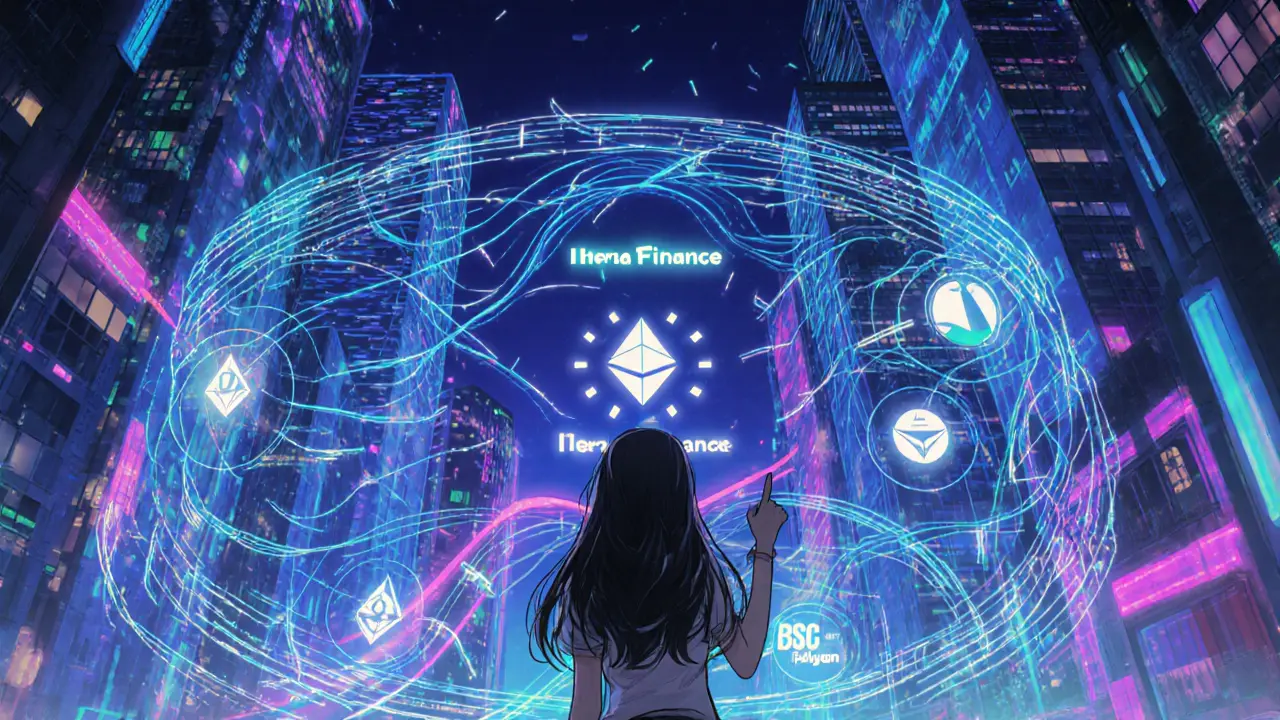HERA Token Value Estimator
Current Market Status
Low liquidity, thin trading pairs, and market volatility indicate caution for investors.
Potential Opportunities
If Interchain feature delivers on promise, could see increased adoption and token value growth.
When people mention Hera Finance is an AI‑driven multichain decentralized exchange (DEX) aggregator designed to locate the most efficient swap routes across several blockchains, the conversation usually turns to how it hopes to out‑pace existing solutions like 1inch or Paraswap. Hera Finance markets itself as a one‑stop‑shop for token swaps, but the reality of its architecture, token economics, and market traction matters more than the hype.
What is Hera Finance?
At its core, Hera Finance is a decentralized platform that aggregates liquidity from various DEXs, stitches together the best price paths, and executes trades in a single transaction. The project’s flagship feature is an AI‑powered “pathfinder” engine that evaluates millions of possible routes, weighing gas costs, slippage, and depth of order books before picking the optimal path. This engine runs on both CPU and GPU resources, allowing it to crunch data faster than most on‑chain routers.
The platform is built primarily for the Andromeda Network a high‑throughput blockchain that supports smart contracts and aims to be a hub for DeFi applications, but its design promises compatibility with any EVM‑compatible chain and even non‑EVM networks, thanks to a modular bridge layer.
How does the HERA token work?
The native utility token, HERA powers the platform’s fee‑sharing model, grants discount tiers for traders and offers a dividend‑like revenue distribution to holders, is issued under the Ethereum contract address 0x6F05709bc91Bad933346F9E159f0D3FdBc2c9DCE. When users swap tokens through the aggregator, a small portion of the transaction fee is converted into HERA and redistributed to token holders, which the team calls a “fair dividend” model.
Beyond fee rebates, HERA acts as a governance token, giving holders a say in future roadmap items such as adding new chains, tweaking fee structures, or upgrading the pathfinder algorithm. However, the exact parameters of the dividend distribution - frequency, calculation method, and sustainability - remain lightly documented, raising questions about long‑term token value.

Technical architecture: Pathfinder core and AI routing
The pathfinder core stands out as the most technically ambitious component. It combines:
- Homogeneous liquidity management - a single liquidity pool view that normalizes data from disparate DEXs.
- Dynamic multihops - the ability to split a single trade into multiple hops across different chains to secure the best combined price.
- Calldata optimization - trimmed transaction payloads that reduce gas consumption.
- Neural tick ranges - AI‑inferred price bands that help anticipate volatility and adjust routes on‑the‑fly.
All of these features rely on a distributed processing network that balances load across nodes, a design that mirrors how modern cloud services scale. The architecture is deliberately chain‑agnostic: while the current deployment leans on Ethereum for smart‑contract logic, the pathfinder can be ported to other virtual machines without a complete rewrite.
Multichain capabilities and the Interchain roadmap
One of Hera Finance’s headline promises is “Interchain” - a single‑transaction, cross‑chain swap that bypasses the need for multiple bridge hops. In theory, a user could trade a token on Binance Smart Chain for one on Polygon, and the platform would orchestrate the entire flow behind the scenes, settling the final state atomically. This would cut down on bridging fees, reduce exposure to bridge hacks, and streamline user experience.
The roadmap lists Interchain as a Q4‑2025 milestone. Early testnets have demonstrated proof‑of‑concept swaps between Ethereum and Andromeda, but full production roll‑out depends on stable bridge contracts, rigorous security audits, and sufficient liquidity on each participating chain.
Market performance and liquidity overview
Despite its technical aspirations, HERA’s market data tells a cautious story. LiveCoinWatch recorded a recent daily high of $1.50, while CoinGecko’s latest price sits around $0.84 with a 24‑hour volume of roughly $77,000. The token’s all‑time high peaked at $10.72, indicating a steep decline in market confidence.
Liquidity is thin. The token trades on only four exchanges - Bilaxy a crypto exchange that lists low‑cap assets, Uniswap (v2) the most popular Ethereum‑based DEX, Netswap, and Hercules V3. Over 99% of the daily trading volume funnels through the HERA/ETH pair, suggesting a severe concentration risk for traders needing to move large sums.
Ranking volatility is also evident: some trackers place HERA at #5,762 by market cap, while others list it near #7,268. The discrepancy highlights the token’s marginal presence in the broader DeFi ecosystem.

Comparison with leading DEX aggregators
| Feature | Hera Finance | 1inch | Paraswap | Matcha |
|---|---|---|---|---|
| AI‑driven route optimisation | Yes (Pathfinder core) | Heuristic algorithms | Heuristic algorithms | Heuristic algorithms |
| Multichain Interchain swaps (live) | Planned Q4‑2025 | Supported via multiple DEXs | Supported via multiple DEXs | Supported via multiple DEXs |
| Native utility token | HERA (fee rebates, dividends) | 1INCH (governance, staking) | PSP (governance) | No native token |
| Liquidity depth | Low - concentrated on few pairs | High - multiple partners | High - wide pool access | Medium - relies on partner DEXs |
| Supported chains | EVM + Andromeda (expanding) | Ethereum, BSC, Polygon, Avalanche, etc. | Ethereum, BSC, Polygon, Fantom, etc. | Ethereum, BSC, Polygon, Optimism, etc. |
The table shows that while Hera Finance aims to differentiate itself with AI‑powered routing and a future Interchain feature, it currently lags behind in liquidity and chain coverage. Established aggregators benefit from years of network effects, larger user bases, and deeper integrations with liquidity providers.
Risks, challenges, and community outlook
Several red flags emerge for potential users:
- Liquidity scarcity - thin order books translate into high slippage for larger trades.
- Tokenomics opacity - the dividend model lacks transparent parameters, making it hard to predict returns.
- Development bandwidth - delivering a truly cross‑chain Interchain swap demands extensive engineering and rigorous audits, which early‑stage projects often struggle to fund.
- Competitive pressure - incumbents like 1inch continuously upgrade their routing engines, narrowing any AI advantage Hera might claim.
Community activity appears muted. Public channels such as Reddit, Discord, or Twitter show low posting frequency, and the project’s GitHub visibility is minimal, with few recent commits. A vibrant developer ecosystem is crucial for rapid bug‑fixes and feature roll‑outs, especially for a platform that touches multiple blockchains.
That said, the concept of a truly multichain aggregator remains compelling. If Hera Finance can deliver a secure, low‑cost Interchain swap and grow its liquidity pools, it could carve out a niche among DeFi power users who trade across chains daily.
Frequently Asked Questions
What problem does Hera Finance aim to solve?
It seeks to eliminate the need for users to manually hop between multiple DEXs and bridges by automatically finding the cheapest, fastest swap route across several blockchains.
How is the HERA token different from other DeFi tokens?
HERA not only grants fee discounts and governance rights but also promises a dividend‑style revenue share from platform fees, although the exact payout formula is still being refined.
Can I trade HERA on major exchanges?
At present, HERA is listed on a handful of niche platforms - Bilaxy, Uniswap v2, Netswap and Hercules V3 - with the bulk of volume in the HERA/ETH pair.
When is the Interchain feature expected?
The development team targets the fourth quarter of 2025 for a public release, pending successful testnet validation and security audits.
Is Hera Finance safe to use?
Safety depends on smart‑contract audits, which the project has partially released. Users should start with small amounts, monitor community updates, and consider the limited liquidity before committing large capital.
Overall, Hera Finance presents an ambitious vision that could pay off if its technical promises materialize and liquidity improves. For now, treat it as an experimental DeFi tool rather than a core portfolio holding.








Andrew Lin
March 18, 2025 AT 15:44Listen up, this so‑called “AI‑powered” DEX aggregator is just another gimmick cooked up by some Silicon Valley wannabes trying to brag about “multichain.” If you think HERA’s gonna blow up just because it uses AI, you’re living in a fantasy. The US market already has enough half‑baked projects, and this one looks like a copy‑paste job. Get real, stop buying hype.
Caitlin Eliason
March 19, 2025 AT 11:11Wow, that’s a hot take! 😅 I actually see some potential in HERA’s interchain vision, especially if they can pull off real liquidity. The market’s thin now, but a solid AI aggregator could attract traders looking for better slippage. Let’s hope the devs deliver on the promises! 🚀
Ken Pritchard
March 20, 2025 AT 06:37Hey folks, just wanted to point out that many new tokens face low liquidity at launch. It’s classic chicken‑and‑egg: traders need liquidity, liquidity needs traders. If you’re considering HERA, maybe start with a small exposure and watch how the volume builds. Also, look into the team’s roadmap – they’ve hinted at partnerships that could boost the multichain feature.
Bryan Alexander
March 21, 2025 AT 02:04Guys, I’m actually pretty excited about HERA! The AI‑driven aggregator could be a game‑changer, slicing through the noise of fragmented DEXes. Imagine a world where you just plug in your token and the best route is auto‑selected – that’s huge for user experience. If the interchain tech lives up to the hype, we could see a surge in adoption. Keep your eyes peeled! 🌟
Patrick Gullion
March 21, 2025 AT 21:31Sure, but I’ll bet the hype fizzles out like most “next‑gen” projects.
Jack Stiles
March 22, 2025 AT 16:57lol this looks like another token trying to be fancy. low liquidity right now, not many pairs. might be a risky play, but who knows.
Sal Sam
March 23, 2025 AT 12:24From a technical standpoint, the aggregator’s architecture leverages on‑chain oracle feeds combined with off‑chain AI inference layers to compute optimal routing. However, the current gas economics on Ethereum and BSC could erode arbitrage margins, especially given the sparse liquidity pools noted.
Lara Decker
March 24, 2025 AT 07:51Honestly, all that jargon doesn’t mask the fact that HERA is just a speculative bubble waiting to burst. The metrics are weak, and any “AI” claim is a marketing ploy.
Anna Engel
March 25, 2025 AT 03:17Ah, another “AI‑powered” miracle cure for DeFi fatigue. Because what we needed was more buzzwords, right?
manika nathaemploy
March 25, 2025 AT 22:44i get the vibe but maybe they really got sum solid tech behind it. not all hype lol.
Mark Bosky
March 26, 2025 AT 18:11In evaluating the Hera Finance (HERA) token, it is essential to adopt a systematic approach that considers both qualitative and quantitative factors. First, the project’s whitepaper delineates an AI‑driven multichain DEX aggregation model that, in principle, could enhance trade execution efficiency. Second, the tokenomics allocate a modest portion of the supply to liquidity mining, which may incentivize early participants. Third, the current market data reveal limited on‑chain activity, as evidenced by low daily volume and a scant number of trading pairs. Fourth, the ecosystem’s governance framework appears to be in a nascent stage, with voting mechanisms yet to be fully operational. Fifth, the development team has publicly announced forthcoming integrations with several layer‑2 solutions, which could address existing scalability concerns. Sixth, a comparative analysis with established aggregators such as 1inch and Paraswap indicates that Hera’s unique value proposition lies primarily in its AI routing algorithm. Seventh, the algorithm’s performance metrics have not been independently audited, which introduces an element of uncertainty. Eighth, the project’s community engagement on platforms such as Telegram and Discord demonstrates a growing but still modest follower base. Ninth, regulatory considerations remain pertinent, given the evolving legal landscape surrounding synthetic assets. Tenth, risk management protocols, including stop‑loss features and slippage controls, are briefly mentioned but lack detailed exposition. Eleventh, the token’s price history exhibits pronounced volatility, a characteristic common to nascent DeFi projects. Twelfth, potential investors should conduct a thorough due‑diligence process, incorporating on‑chain analytics and third‑party reviews. Thirteenth, the strategic roadmap outlines a phased rollout of cross‑chain capabilities, which, if realized, could bolster utility. Fourteenth, the presence of a transparent treasury and clear allocation of funds enhances credibility. Finally, while the concept holds promise, prospective participants must weigh the inherent risks against the prospective benefits before allocating capital.
Marcus Henderson
March 27, 2025 AT 13:37Building on Mark’s comprehensive overview, I would emphasize the importance of third‑party security audits, particularly for the AI inference modules, as they represent a critical attack surface. Additionally, monitoring the on‑chain liquidity depth over the next quarter will provide actionable insights into market confidence.
Debra Sears
March 28, 2025 AT 09:04I get that many of us are nervous about low liquidity, but remember that every project starts somewhere. If you believe in the team’s vision, a small, measured position can be a way to support the ecosystem while managing risk.
Darren Belisle
March 29, 2025 AT 04:31Wow!!! This HERA token really does have a lot of moving parts!!! AI, multichain, DEX aggregation!!! It’s like a buffet of tech!!! But remember, the devil is in the details!!!
Heather Zappella
March 29, 2025 AT 23:57The technical documentation specifies that the AI routing engine utilizes a reinforcement learning model trained on historical trade data, aiming to minimize slippage across supported chains. This level of detail suggests a serious engineering effort.
Kate O'Brien
March 30, 2025 AT 19:24Honestly, I think the whole thing is a front. Big players love to push these “AI” tokens to distract us while they move their own money behind the scenes.